The Xeon Entry Quad-Core CPU Review: Xeon E-2174G, E-2134, and E-2104G Tested
by Ian Cutress on March 11, 2019 10:30 AM EST- Posted in
- CPUs
- Xeon
- Enterprise CPUs
- Coffee Lake
- Xeon E
- C246
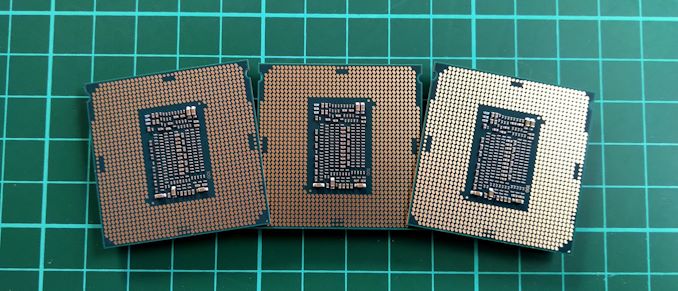
A couple of months ago we reviewed a few of the newest six-core Intel commercial CPUs that are also used in low-end servers. Intel has also launched some quad-core models, which we are focusing on today. These Xeon E quad-core processors compete directly against AMD's Ryzen Pro product line, focusing on manageability, ECC memory support, and guaranteed product longevity.
Xeon E: the New Xeon E3
When Intel moved away from its Xeon E5/E7 naming scheme for its server processors, there was a substantial outcry from IT procurement everywhere. By removing a system that was well known and replacing it with exotic metal names such as Xeon Platinum, Xeon Gold, Xeon Silver, and Xeon Bronze, everyone knew it would mean relearning Intel's product segmentation rules and also teaching it to the executives that would sign off on purchasing rules. The mainstream server market was not the only one to go through a name change - the popular workstation processor models were renamed Xeon W, and the last domino to fall was the Xeon E3-1200 processor line, now named Xeon Entry, or E for short.
| Intel Xeon Naming Strategy | |||||||||
| SNB | IVB | HSW | BDW | SKL | Future | ||||
| Servers | E7-8000 | 'v1' | v2 | v3 | v4 | Xeon SP Platinum Xeon SP Gold Xeon SP Silver Xeon SP Bronze |
|||
| E7-4000 | 'v1' | v2 | v3 | v4 | |||||
| E7-2800 | 'v1' | v2 | - | - | |||||
| E5-4600 | 'v1' | v2 | v3 | v4 | |||||
| E5-2600 | 'v1' | v2 | v3 | v4 | |||||
| E5-2400 | 'v1' | v2 | v3 | - | |||||
| Workstations | E5-1600 | 'v1' | v2 | v3 | v4 | Xeon W | |||
| E5-1400 | 'v1' | v2 | v3 | - | - | - | - | - | |
| SNB | IVB | HSW | BDW | SKL | KBL | CFL | CFL-R | ||
| Mobile | E3-1500M | - | - | - | - | v5 | v6 | E-2100 | ? |
| Consumer | E3-1200 | 'v1' | v2 | v3 | v4 | v5 | v6 | E-2100 | E-2200? |
| Comms | E3-1100 | 'v1' | v2 | - | - | - | - | - | - |
| Network | Xeon-D | - | - | - | D-1500 | D-2100 |
|||
The latest launch, which would have been the Xeon E3-1200 v7, becomes the first generation of Xeon E-2100, bringing it in line with the workstation processors (Xeon W-2100) and the networking/compute crossover family (Xeon D-2100). Intel launched 11 processors, a range of quad-core and six-core parts, using the Coffee Lake microarchitecture.
In our previous review, we tackled the six core parts: the E-2186G, the E-2176G, the E-2146G and the E-2136 processors. This time around we are focusing on the quad-core parts we have tested - the E-2174G, the E-2134, and the E-2104G. For these processors, the final digit shows the core count, and the G indicates integrated graphics.
The Xeon E family are derivatives of the consumer processor line, but instead are locked to C236 chipset motherboards but support ECC memory. This means they primarily fit into the commercial market, where businesses will have prebuilt systems with error correcting memory for data safety. These processors also support vPro, enabling management features across a network, and both virtualization options (VT-x and VT-d) that enable the parts for virtualized networks.
The Xeon E-2174G is the top quad-core processor of this line, with hyperthreading and with a 3.8 GHz base frequency and a 4.7 turbo frequency. As we discovered in our six core review, these processors and the motherboard manufacturers tend to stick to the strict Intel defaults when it comes to power management, unlike the consumer motherboard segment. This means we should expect it to perform similar to consumer processors in single-threaded tests, but in multithreaded expect it to max out at its all-core turbo frequency. At 71W for TDP, we would expect this to also be the sustained load power consumption too.
The E-2134 is a lower clocked variant without graphics, however the E-2104G is far more interesting. This processor is an off roadmap part, meaning it isn't sold to retail or distributors, but to specific OEMs that wanted this configuration. In this case, it is a lower TDP quad-core processor (65W rather than 71W) with no turbo frequency - 3.2 GHz all the time when at load. It still has integrated graphics, but has the lowest turbo frequency at 1100 MHz.
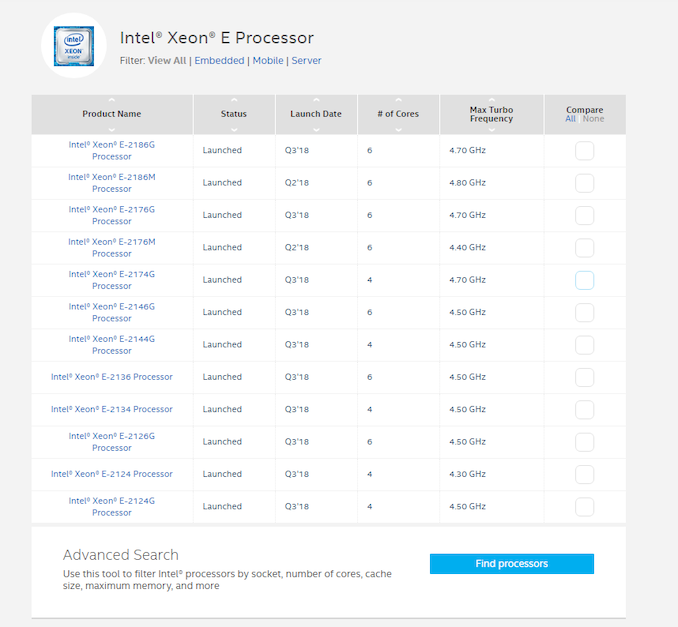
Xeon E-2104G doesn't show up on Intel's Database 'ARK' under Xeon E, as it is off-roadmap
Alternatives to Xeon E
From Intel, if you still want a Xeon, then the Xeon Scalable line has some low frequency six core Bronze processors that are at $350. If you don't need ECC or manageability options, then Intel's consumer parts offer extra performance.
From AMD, these Xeon Entry processors compete up against the Ryzen Pro family, which offers similar management options (through DASH), as well as ECC support (depending on the motherboard), long term stability, and a wider range of options from eight core to quad core. The Ryzen Pro parts are identical in specifications to their desktop counterparts. For anyone looking for the Ryzen Pro chips in retail packaging though, you're out of luck - AMD only sells these to OEMs. Unfortunately we haven't been sampled these parts either - we only have a solitary SKU I purchased from China with my own money.
Pages In This Review
- Analysis and Competition
- Test Bed and Setup
- 2018 and 2019 Benchmark Suite: Spectre and Meltdown Hardened
- CPU Performance: System Tests
- CPU Performance: Rendering Tests
- CPU Performance: Office Tests
- CPU Performance: Encoding Tests
- CPU Performance: Web and Legacy Tests
- Gaming: Integrated Graphics
- Gaming: World of Tanks enCore
- Gaming: Final Fantasy XV
- Gaming: Shadow of War
- Gaming: Civilization 6
- Gaming: Ashes Classic
- Gaming: Strange Brigade
- Gaming: Grand Theft Auto V
- Gaming: Far Cry 5
- Gaming: Shadow of the Tomb Raider
- Gaming: F1 2018
- Power Consumption
- Conclusions and Final Words


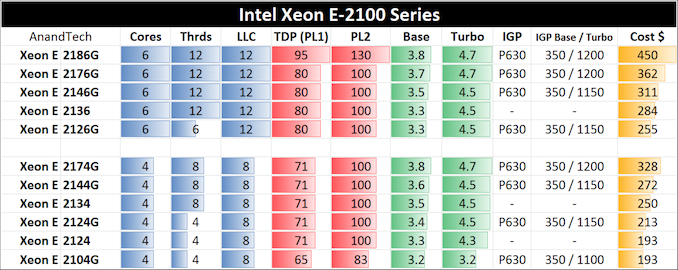
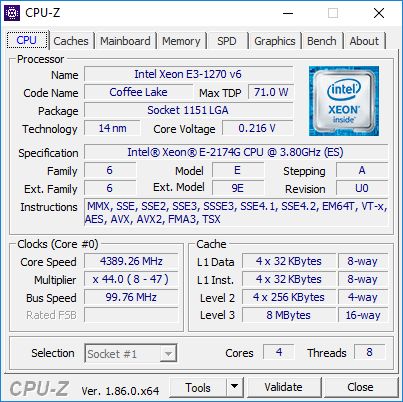
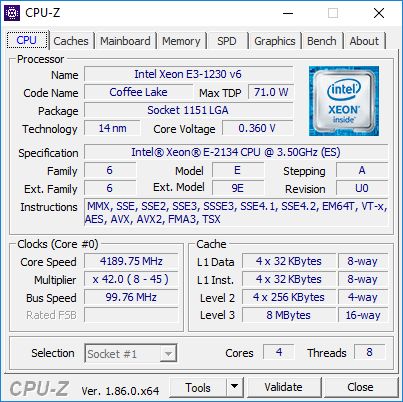
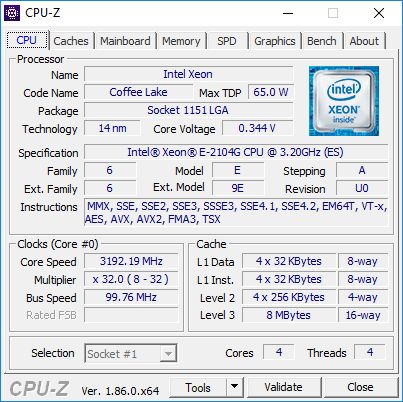








29 Comments
View All Comments
mode_13h - Monday, March 11, 2019 - link
Those interested in ECC-support should also consider Intel's Core i3 CPUs. Most of those also support ECC. Do check their site, to be certain:https://ark.intel.com/content/www/us/en/ark/search...
mode_13h - Monday, March 11, 2019 - link
Also, it should go without saying that you need to pair it with a motherboard with ECC support.mode_13h - Monday, March 11, 2019 - link
For instance, compare the E-2174G with the i3-8350K:https://ark.intel.com/content/www/us/en/ark/compar...
eastcoast_pete - Monday, March 11, 2019 - link
Thanks Ian! While I know that my following suggestion might be overly simple, I like to also look at the value for money, especially for business tech like that. To do so, I simply divide the benchmarks by the price, resulting in performance/$ . If nothing else, it makes it easier to compare hardware that is at least within a certain range. Doing that, the Ryzen 2600 is the overall price/performance champion, whereas the Xeon 2146G is the likely choice if more speed and other features become important. I don't see much upside in the premium four core (2174G) over the (cheaper and usually faster ) six core 2146G.eastcoast_pete - Monday, March 11, 2019 - link
This didn't make it into my comment:Question @Ian: I saw you mention the performance /price once in your article, but is there a way to show that" Bang for the Buck" in a summary graph? I believe it might help put things into perspective, especially when comparing CPUs or GPUs where the most expensive costs 2-3 times as much as the cheapest.
msroadkill612 - Tuesday, March 12, 2019 - link
The 2600 is on sale for 7 days at newegg for $165, but it seems the going regular price for it atm.msroadkill612 - Tuesday, March 12, 2019 - link
TLDR,but buyers should also consider cooling and mobo relative costs also. afaik, many, if not all intels have no cooler, whereas tha amd included ones are regarded as qyute decent if not overclocking.peevee - Tuesday, March 19, 2019 - link
What a terrible mess the whole Intel lineup is.bimuzubi - Sunday, December 8, 2019 - link
Definitely, but here the power envelope is important for the test, which Anandtech doesn't seem to give. It's quite worrisome how most of those Xeons are operating outside of their power envelope, that E-2174G that you are referring to is pulling 85W for a rated 71W, so Intel gives a P2 power limit. Why bother with the normal TDP then? The 2600 seems to be owning price/performance and TDP/performance. Question there is EEC memory support, and the guarantee/testing including with Xeons https://adultpornroll.com/category/asian-porn-tube... . That's why I mentioned including TR in the benchmarks, or at least the 2700X.